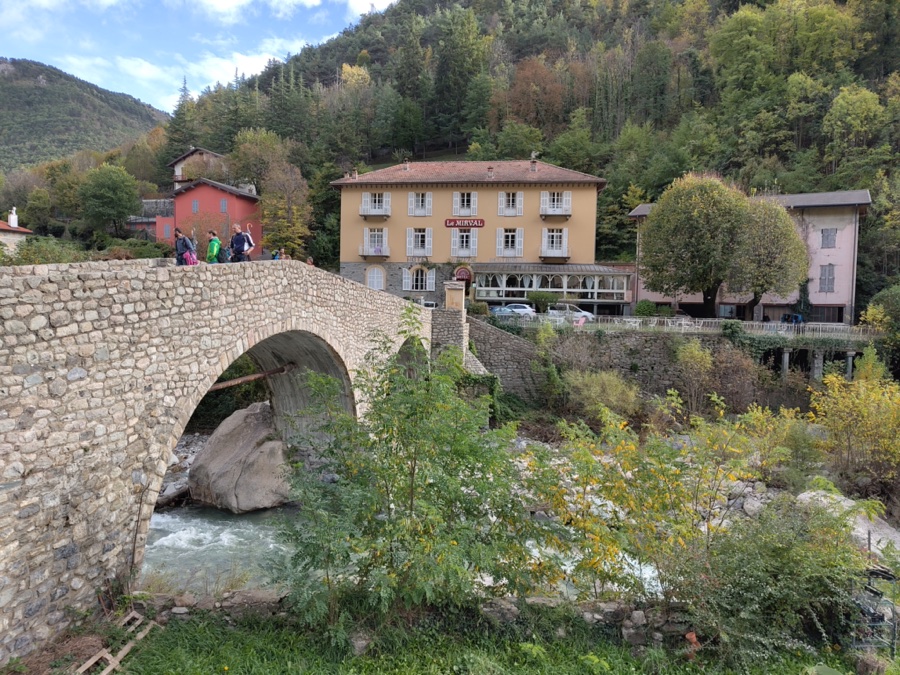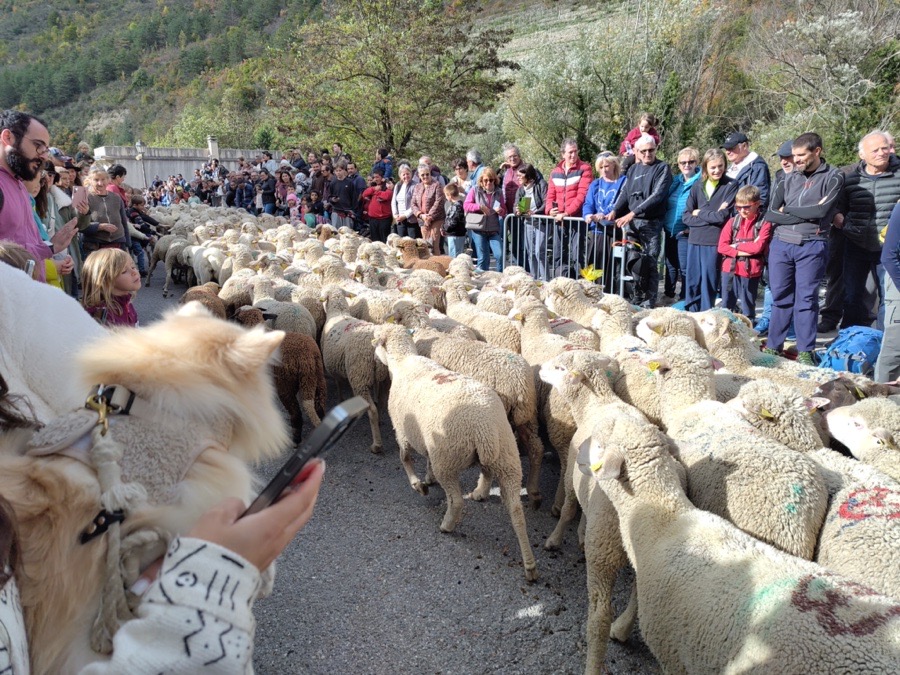A stay at La Brigue, with sheep
Nice is situated at the foot of a stunning mountain range, part of the Alps, which is very good for hiking at the right times of year. Getting to the know the mountains around Nice is certainly as rewarding as finding secluded coves to swim in or new restaurants to try.
If this sounds daunting to those who don’t bring a car to Nice, think again. Many mountain villages, such as St Etienne de Tinée, Roquebilière and St Martin sur Vésubie, can be accessed from Nice for the price of a single bus journey.
And then there are the small train lines that take a lazy journey along the villages nestling in some of the lower mountain ranges. We planned, one October, to take one of these to La Brigue where we wanted to spend a couple of days walking.
The “marvellous” line to La Brigue
La Brigue is on the train line that leads north towards Cuneo in Italy. On its way, the train serves a series of mountain villages (“villages perchés”) along the Roya river, many having ancient origins linked to the “route du sel”, the transport of salt across the mountains. This line runs from Nice Ville station and is known rather grandly as “le Train des Merveilles”, the train of marvels.
Except right now, it isn’t running. Because of engineering works, the line is down from September 2024 until the end of 2025, to the fury of the villages that rely on it for tourism and other needs. And the SNCF replacement bus only travels as far as Breil after which travellers to Saorge, La Brigue and Tende have to wait over an hour for the scheduled bus 25 to come up from Menton and take them further. It’s a pretty poor show.
Enter the sheep
We were grappling with how to get to La Brigue when we learned that SNCF were laying on extra buses from Nice directly there, on the very day we wanted to go. Why? Because the annual festival of ewes, the “Fête de la brebis”, fell on that day. Asking no questions, we booked a place on one of three minibuses that wound its way up the mountain. Even with a complicated route in and out of the Italian border, and a driver checking his phone every few minutes for directions, we arrived in La Brigue just as it was getting busy.

The festival celebrates the “brigasque sheep”, a robust mountain breed favoured for its endurance and its high-quality milk. The festival’s timing in autumn recalls one of the main events of mountain sheep husbandry, called in French “la transhumance”, the great movements of the flocks onto the mountains in the spring and back down to the valleys in the autumn.
Along with dozens of locals and hundreds of visitors from Nice, Italy and the surrounding villages, we enjoyed a range of stalls selling sheep products and refreshments of all kinds. The restaurants were run off their feet. The open spaces being small, more stalls extended along the quiet main road and into the various squares linked by narrow streets. A highlight for us was watching locals dance to a folk band, twirling tarantellas and balletti not unlike our English barn dances.
The afternoon attraction was the procession of the ewes. Preceded by a small brass band, a river of the animals ran down the main road past rows of excited onlookers, to be corralled into a large pen and loaded on double-decker vehicles. To the disappointment of some visitors, they did not appear to be of the distinctive Brigasque type.

Enjoying our stay
We stayed a couple of excellent nights at L’Auberge St Martin in La Brigue. The day after the festival, we hiked over some low-ish mountains to the larger settlement of Tende. There we bought lunch from a bakery, La Boulangerie des Merveilles, and checked in with the tourist office to plan future hikes in the Mercantour Park. The museum next door has an exceptional exhibition devoted to prehistoric markings and engravings found in the Mercantour: these are the actual “merveilles” to which so many local names make reference.
La Brigue, Tende, and the other villages on the Merveilles train line are worth visiting for their sheer beauty. Built around characteristic narrow streets and archways, the houses cling to the mountains in their many shades of ochre and red. Most villages are bisected by the river Roya which runs all the way to the Italian border town of Ventimiglia. Of which more later.
Getting back to Nice – by train?
And so to plan the return journey, without the advantage of the special ‘”sheep minibuses” that had ferried festival-goers back to Nice immediately after the big do. “Il n’y a pas de train,” we were repeatedly told by locals. We would find no train at all, and the SNCF app appeared to bear this out.
Except that we did see trains at La Brigue station conveying Italian visitors home. What we haven’t explained is that Italian trains also use this line, on a branch that departs from Vengimiglia and serves a few mountain villages on the Italian side of the border before crossing into France. This Italian branch joins the French line at Breil-sur-Roya, continues through La Brigue and Tende and crosses back into Italy to reach the terminus at Cuneo. When the French trains from Nice are running at all, they only go as far as Tende.
These oddities are explained by the fact that Tende and La Brigue used to be in Italy. The towns are part of a small territory that was conceded to France after World War II, which is why the roads weave in and out of the re-drawn border, as do the train lines and the river Roya. The closeness of the border is credited with keeping folk music and dancing alive in this remote region.
Ventimiglia is on the coast and connected to Nice by frequent trains unaffected by the enginieering works. We decided that if trains were running from La Brigue to Ventimiglia, the detour via Italy would be a perfectly acceptable way of returning to Nice. But to frustrate our plans, SNCF doesn’t show the train from La Brigue to Ventimiglia on its system.
Thus the French railways have further let the villagers down by refusing to acknowledge the train from Ventimiglia as an alternative for getting between Breil and the higher stations up to Tende. And the locals have bought into this logic, wrapped up as they are between their anger at the temporary loss of the regular train and their fear that the authorities may try to axe it entirely.
For them, there is indeed no train.
Catching the ghost train
So it was against advice that we tried to buy tickets online for the non-existent train. The Tren Italia app, downloaded for this purpose, listed the route but would not allow ticket purchases for journeys from the French stations. And once we started tracking our chosen train as it set off from Cuneo, we found that Tren Italia does not list the French destinations by name and that the tracking stopped after the train crossed the French border. Tren Italia was also doing its best to ignore the inconvenient French section of its route.
The train was late but it did arrive, just as I had begun to doubt its existence. And we had an entirely free ride because there was no means of buying tickets even on board. As we called at all the French stations and then all the Italian ones to Ventimiglia, we saw only one person board at a French station.
And yet the journey itself is glorious. Between the long stretches of tunnel, we enjoyed tantalising glimpses of sun-drenched views of the river Roya, mountains and precariously perched villages. Inside the tunnels, the train does large, slow loops that facilitate the change of altitude. The tunnel route can be seen in detail on map apps like Open Street Map and Mapply: it’s an extraordinary feat of engineering that puts today’s railway engineering to shame.
Arrived at Ventimiglia, we gratefully indulged in caffe macchiato and some unusual charcoal croissants before continuing to Nice.
Don’t be put off
All these towns and villages have suffered devastation from Storm Alex that occurred in the same year as the pandemic, 2020. They are beautiful and worth preserving as living communities with their farming and their industries. They have a great deal to offer hiking and mountaineering enthusiasts, and they need all the support they can get from our visits.
Good to know:
There is an excellent recipe from this area on the recipe pages of this website! See Vegetable pie with olive oil pastry